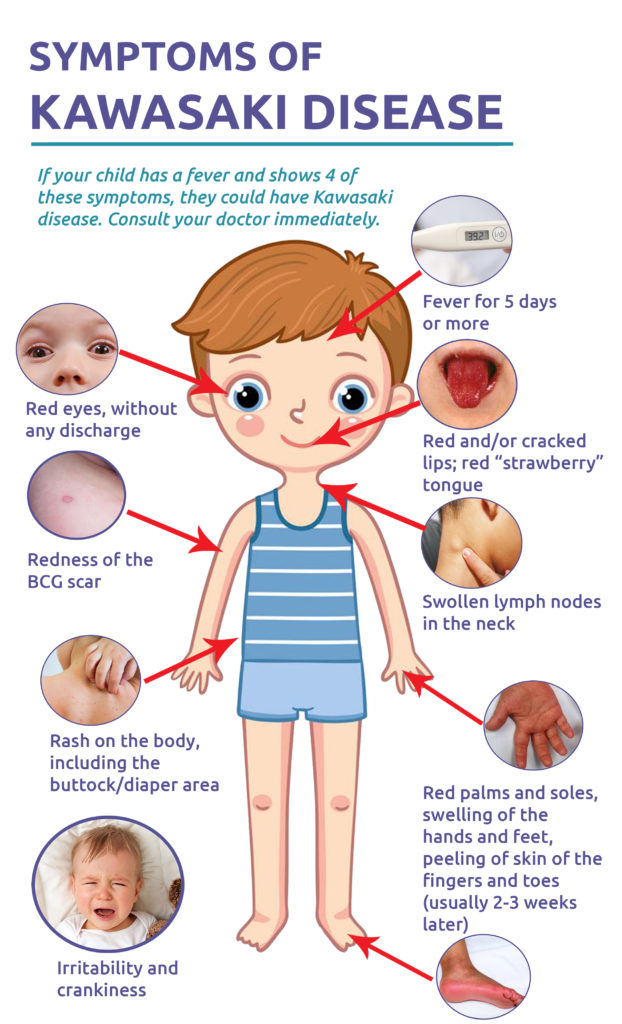With this definition in mind during phase three your child will start to recover from Kawasaki disease through treatment. In Kawasaki disease the fever usually lasts for more than five days and is not very responsive to normal treatment.
 Autoimmune Diseases Kawasaki Disease Healthway Medical
Autoimmune Diseases Kawasaki Disease Healthway Medical
Kawasaki disease is an acute vascular illness in children between 6 months to 5 years and presents with fever and signs and symptoms that often appear sequentially.

Kawasaki illness symptoms. It is a form of vasculitis or inflammation of the blood vessels that happens when the immune system attacks them by mistake. Clinical signs include fever rash swelling of the hands and feet irritation and redness of the whites of the eyes swollen lymph glands in the neck and irritation and inflammation of the mouth lips and throat. The first and most common symptom of Kawasaki disease is usually a high temperature fever of 38C or above.
Red fingers or toes. Since the symptoms are similar to other childhood diseases including the measles scarlet fever and juvenile arthritis. High fever above 101 F that lasts more than 5 days.
The characteristic symptoms are a high temperature that lasts for 5 days or more with. A pink rash on the back belly arms legs and genital area. The usual symptoms and signs of Kawasaki disease include prolonged fever about 5 days reddening of the eyes without pus pinkeye cracked and inflamed lips and mucous membranes of the mouth with an inflamed strawberry tongue.
The temperature is usually above 39 to 40 degrees Celsius. Fever of at least 5 days and at least 4 of the following symptoms red. The first phase which can last for up to 2 weeks usually involves a fever that lasts for at least 5 days.
Doctors do not know what causes Kawasaki disease though they believe genetic and environmental factors may play a role. What Are the Signs Symptoms of Kawasaki Disease. Kawasaki disease is a serious illness but a complete recovery is possible.
After a few weeks and with the correct treatment the symptoms become less severe but it can take longer than this in some children. During this phase the symptoms will lessen and start to improve and eventually disappear. A fever is a nonspecific and common symptom observed in various conditions such as viral infections parasitic infections bacterial infections vasculitis and deep vein thrombosis.
Currently no one specific test can confirm Kawasaki disease. Kawasaki disease KD or mucocutaneous lymph node syndrome is an illness that causes inflammation in arteries veins and capillaries. Kawasaki disease which is marked by symptoms including rash and strawberry tongue or a swollen and bumpy tongue is a potentially fatal diagnosis now affecting children who have or.
Kawasaki disease is an illness that affects young children. Swollen glands in the neck. Rash andor peeling skin often between the chest and legs and in the genital or groin area Swelling and redness in hands and.
Doctors are describing it as a new phenomenon similar to Kawasaki disease shock syndrome - a rare condition that mainly affects children under the age of. The disease is the most common cause of acquired heart disease in children and untreated can result in heart attacks. Pronounced kon-vuh-les-uh nt convalescent refers to a period of regaining strength and recovering from an illness.
Read more about the symptoms of Kawasaki disease. Kawasaki disease has telltale symptoms and signs that appear in phases. It wont go down even if a child takes medication that usually.
Signs of the first phase of Kawasaki disease include. The fever can come on quickly and doesnt respond to antibiotics or medicines typically used to reduce a fever such as ibuprofen or paracetamol. A fever also can be a side effect of medications.
Signs and symptoms are as follows.